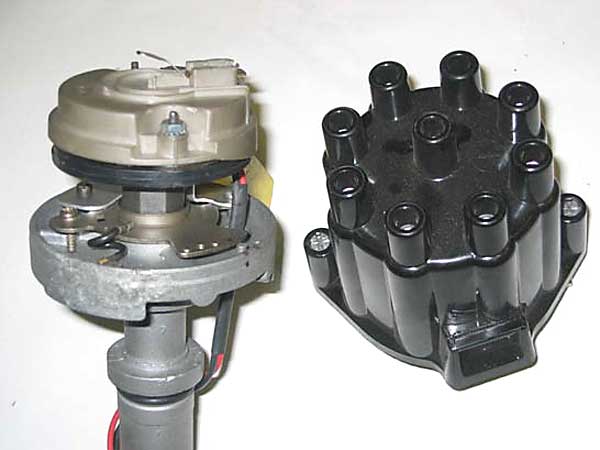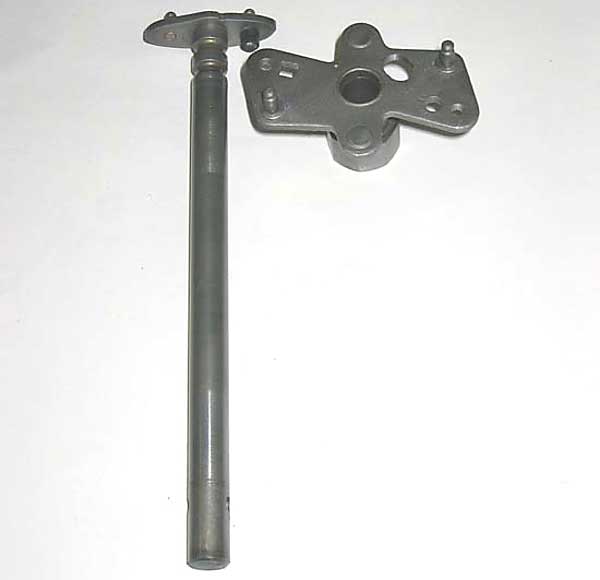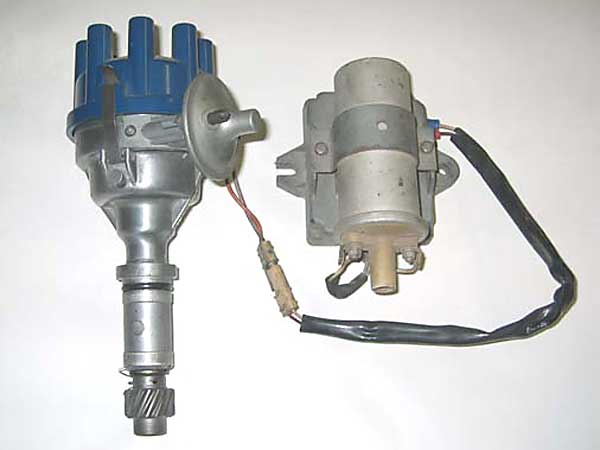Photo 1: 35DM8. Notice amplifier behind coil, making it less susceptible to engine heat
3, 2, 1, Ignition! (Selecting a Rover Distributor)
This article appeared in The British V8 Newsletter - Volume IV, Issue 1 - January 2006by: Jean Monfort
If you fit SUs and a stock cam on your Rover/Buick V8, you will have a large choice of distributors. Does a Lucas work very well? Are the high power ones, coming from a Range Rover, the best?
First, some info about the Lucas. Most are oldies, and must be checked to see if the mechanical and vacuum advance units are in good working order. You should check the condition of the shaft, too.
Lucas made four types of distributors. The serial number is stamped on the body, close
to the vacuum unit.
1 - The early single point (serial number 35D8): Most come from a 3500 P6 and can produce erratic spark timing and poor power, but no more than any other old single point. The vacuum systems often suffer from wear (the rubber diaphragm can degrade) and must be changed. If the mechanical portion is not tired, they may be reliably upgraded with one of the many add-on electronic ignition kits.
2 - About 1976 to 1982 (serial number 35DE8): This one is the bad boy of the company; he is internally amplified and is impossible to repair, or to upgrade. In addition, he's very sensitive to temperature changes. If you have tachometer problems, this distributor is probably responsible.
3 - 1983 to 1984 (serial number 35DM8): These were fitted onto SD1 and some Range Rovers. They have the amplifier and coil fitted together on the fender-well and will never suffer from overheating. They are probably the best system coming from a carbureted donor car.
4- 1985 and later Range Rover (serial number 35DLM8): Has a black amplifier fixed onto the outside of the distributor body. Better than the 35DE8, but the "black box" is not well ventilated and is temperature sensitive.
These different types were fitted to carbureted engines, to injected engines, to 3.5, to 3.9. Having said that, it's easy to understand that Lucas offered a lot more than just 9 specific curve settings. Which is the right one? Some "rules" to follow:
1 - Avoid those models calibrated for injected engines. They have a very large curve. So, to get the 32/34 required degrees over 3000-4000 rpm, the advance at idle must be clamped at 0 to 3 degrees!
2 - Never fit a "points" coil to an electronic distributor and vice-versa.
3 - Always check the height of the rotor in its working position. The rotors all seem to be the same size, but Lucas made two types of wells. Consequently, the rotors can sit high or low. It is imperative to match shallow caps with lowered rotors (deepest wells), and the deepest caps with shallow wells.
So, it is not easy to select the best distributor, and the worries really start with an upgraded camshaft. A higher vacuum inside the inlet manifold changes the vacuum advance unit's reactions. That is the reason why the Edelbrock-Weber comes in one of two ways: a timed vacuum port and a full time vacuum port. On a Rover, equipped with a 50232 cam, the vacuum can exceed 10'' Hg, which is enough to damage the unit! Timed or not, my vacuum Lucas never liked my four barrel Weber.

Photo 2: Buick distributor fitted with Pertronix ignition module
1 - The early single point (serial number 35D8): Most come from a 3500 P6 and can produce erratic spark timing and poor power, but no more than any other old single point. The vacuum systems often suffer from wear (the rubber diaphragm can degrade) and must be changed. If the mechanical portion is not tired, they may be reliably upgraded with one of the many add-on electronic ignition kits.
2 - About 1976 to 1982 (serial number 35DE8): This one is the bad boy of the company; he is internally amplified and is impossible to repair, or to upgrade. In addition, he's very sensitive to temperature changes. If you have tachometer problems, this distributor is probably responsible.
3 - 1983 to 1984 (serial number 35DM8): These were fitted onto SD1 and some Range Rovers. They have the amplifier and coil fitted together on the fender-well and will never suffer from overheating. They are probably the best system coming from a carbureted donor car.
4- 1985 and later Range Rover (serial number 35DLM8): Has a black amplifier fixed onto the outside of the distributor body. Better than the 35DE8, but the "black box" is not well ventilated and is temperature sensitive.
These different types were fitted to carbureted engines, to injected engines, to 3.5, to 3.9. Having said that, it's easy to understand that Lucas offered a lot more than just 9 specific curve settings. Which is the right one? Some "rules" to follow:
1 - Avoid those models calibrated for injected engines. They have a very large curve. So, to get the 32/34 required degrees over 3000-4000 rpm, the advance at idle must be clamped at 0 to 3 degrees!
2 - Never fit a "points" coil to an electronic distributor and vice-versa.
3 - Always check the height of the rotor in its working position. The rotors all seem to be the same size, but Lucas made two types of wells. Consequently, the rotors can sit high or low. It is imperative to match shallow caps with lowered rotors (deepest wells), and the deepest caps with shallow wells.
|
Enjoying this article? Our magazine is funded through the generous support of readers like you! To contribute to our operating budget, please click here and follow the instructions. (Suggested contribution is twenty bucks per year. Feel free to give more!) |
So, it is not easy to select the best distributor, and the worries really start with an upgraded camshaft. A higher vacuum inside the inlet manifold changes the vacuum advance unit's reactions. That is the reason why the Edelbrock-Weber comes in one of two ways: a timed vacuum port and a full time vacuum port. On a Rover, equipped with a 50232 cam, the vacuum can exceed 10'' Hg, which is enough to damage the unit! Timed or not, my vacuum Lucas never liked my four barrel Weber.

Photo 2: Buick distributor fitted with Pertronix ignition module
Later on, I decided to fit 4 x 45 DCOE Webers to a 4.0 Rover. One more time the question
of appropriate advance came up. And the challenge really began with the installation of
a mechanical, dual point Mallory. Poor performance, points troubles, 3 burned condensers
a week! Some observation and tuning and as result, I got something like a so-so Lucas.
No more. A new Buick-Pertronix from D&D was a must. Simple and efficient? Yes it is!
But fitted without any vacuum (removed) I encountered a new difficulty. The Rover
engine advance curve needs a 24 degree range of advance: from 6 degrees at 600rpm and
8 to 12 degrees at 1000RPM to 30-34 degrees at 4000RPM and over, according to the needs
of the camshaft, compression ratio etc. My new Pertronix-converted Delco only gave a
range of 15 degrees!

Photo 3: Axle and Butterfly Plate

Photo 3: Axle and Butterfly Plate
The answer to the problem is easy:
1 - Remove the distributor and all internal components to get the main axle in your hand. The travel of the "butterfly" plate is restricted with a rubber protected dowel which consequently reduces the ignition timing range. Note: The rubber protection is the first thing to check on any old distributor.
2 - The axle is topped by a removable plate.
3 - Have a look at the oval hole drilled in the small plate.
4 - This hole must be lengthened by .020", probably a little bit more. Be careful: if you mill too much, you will be obliged to braze a drop of copper to reduce the incision's length.
5 - Having carefully performed the above surgery, reassemble and check your advance using a timing lamp. If there is not enough advance gain, remove all the parts and mill again. It's empirical, but the only way without expensive tools.
6 - In the quest of the best advance management, it may be advisable to buy a cheap Summit G5212 kit.
Disclaimer: This page was researched and written by Jean Monford. Views expressed are those of the author, and are provided without warrantee or guarantee. Apply at your own risk.
1 - Remove the distributor and all internal components to get the main axle in your hand. The travel of the "butterfly" plate is restricted with a rubber protected dowel which consequently reduces the ignition timing range. Note: The rubber protection is the first thing to check on any old distributor.
2 - The axle is topped by a removable plate.
3 - Have a look at the oval hole drilled in the small plate.
4 - This hole must be lengthened by .020", probably a little bit more. Be careful: if you mill too much, you will be obliged to braze a drop of copper to reduce the incision's length.
5 - Having carefully performed the above surgery, reassemble and check your advance using a timing lamp. If there is not enough advance gain, remove all the parts and mill again. It's empirical, but the only way without expensive tools.
6 - In the quest of the best advance management, it may be advisable to buy a cheap Summit G5212 kit.
Disclaimer: This page was researched and written by Jean Monford. Views expressed are those of the author, and are provided without warrantee or guarantee. Apply at your own risk.


